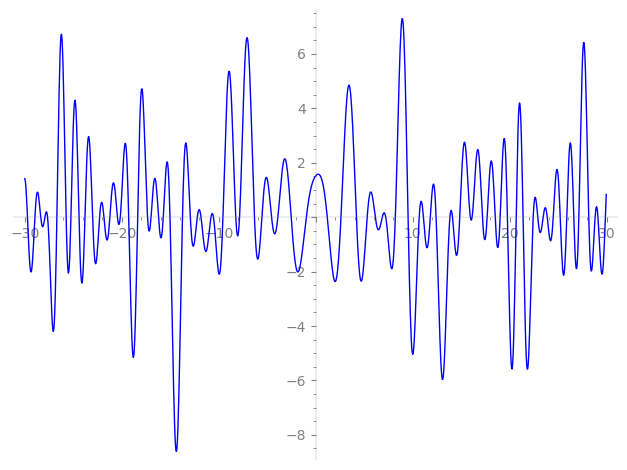| L(s) = 1 | + (0.309 − 0.951i)2-s + (−1.61 + 1.17i)3-s + (0.809 + 0.587i)4-s + (−0.618 − 1.90i)5-s + (0.618 + 1.90i)6-s + (0.809 + 0.587i)7-s + (2.42 − 1.76i)8-s + (0.309 − 0.951i)9-s − 1.99·10-s − 2·12-s + (1.23 − 3.80i)13-s + (0.809 − 0.587i)14-s + (3.23 + 2.35i)15-s + (−0.309 − 0.951i)16-s + (1.23 + 3.80i)17-s + (−0.809 − 0.587i)18-s + ⋯ |
| L(s) = 1 | + (0.218 − 0.672i)2-s + (−0.934 + 0.678i)3-s + (0.404 + 0.293i)4-s + (−0.276 − 0.850i)5-s + (0.252 + 0.776i)6-s + (0.305 + 0.222i)7-s + (0.858 − 0.623i)8-s + (0.103 − 0.317i)9-s − 0.632·10-s − 0.577·12-s + (0.342 − 1.05i)13-s + (0.216 − 0.157i)14-s + (0.835 + 0.607i)15-s + (−0.0772 − 0.237i)16-s + (0.299 + 0.922i)17-s + (−0.190 − 0.138i)18-s + ⋯ |
\[\begin{aligned}\Lambda(s)=\mathstrut & 847 ^{s/2} \, \Gamma_{\C}(s) \, L(s)\cr =\mathstrut & (0.780 + 0.625i)\, \overline{\Lambda}(2-s) \end{aligned}\]
\[\begin{aligned}\Lambda(s)=\mathstrut & 847 ^{s/2} \, \Gamma_{\C}(s+1/2) \, L(s)\cr =\mathstrut & (0.780 + 0.625i)\, \overline{\Lambda}(1-s) \end{aligned}\]
Particular Values
| \(L(1)\) |
\(\approx\) |
\(1.43471 - 0.504177i\) |
| \(L(\frac12)\) |
\(\approx\) |
\(1.43471 - 0.504177i\) |
| \(L(\frac{3}{2})\) |
|
not available |
| \(L(1)\) |
|
not available |
\(L(s) = \displaystyle \prod_{p} F_p(p^{-s})^{-1} \)
| $p$ | $F_p(T)$ |
|---|
| bad | 7 | \( 1 + (-0.809 - 0.587i)T \) |
| 11 | \( 1 \) |
| good | 2 | \( 1 + (-0.309 + 0.951i)T + (-1.61 - 1.17i)T^{2} \) |
| 3 | \( 1 + (1.61 - 1.17i)T + (0.927 - 2.85i)T^{2} \) |
| 5 | \( 1 + (0.618 + 1.90i)T + (-4.04 + 2.93i)T^{2} \) |
| 13 | \( 1 + (-1.23 + 3.80i)T + (-10.5 - 7.64i)T^{2} \) |
| 17 | \( 1 + (-1.23 - 3.80i)T + (-13.7 + 9.99i)T^{2} \) |
| 19 | \( 1 + (5.87 - 18.0i)T^{2} \) |
| 23 | \( 1 + 4T + 23T^{2} \) |
| 29 | \( 1 + (-4.85 - 3.52i)T + (8.96 + 27.5i)T^{2} \) |
| 31 | \( 1 + (-3.09 + 9.51i)T + (-25.0 - 18.2i)T^{2} \) |
| 37 | \( 1 + (-4.85 - 3.52i)T + (11.4 + 35.1i)T^{2} \) |
| 41 | \( 1 + (3.23 - 2.35i)T + (12.6 - 38.9i)T^{2} \) |
| 43 | \( 1 - 12T + 43T^{2} \) |
| 47 | \( 1 + (-8.09 + 5.87i)T + (14.5 - 44.6i)T^{2} \) |
| 53 | \( 1 + (1.85 - 5.70i)T + (-42.8 - 31.1i)T^{2} \) |
| 59 | \( 1 + (1.61 + 1.17i)T + (18.2 + 56.1i)T^{2} \) |
| 61 | \( 1 + (-49.3 + 35.8i)T^{2} \) |
| 67 | \( 1 - 8T + 67T^{2} \) |
| 71 | \( 1 + (3.70 + 11.4i)T + (-57.4 + 41.7i)T^{2} \) |
| 73 | \( 1 + (-6.47 - 4.70i)T + (22.5 + 69.4i)T^{2} \) |
| 79 | \( 1 + (-2.47 + 7.60i)T + (-63.9 - 46.4i)T^{2} \) |
| 83 | \( 1 + (-67.1 + 48.7i)T^{2} \) |
| 89 | \( 1 + 6T + 89T^{2} \) |
| 97 | \( 1 + (3.09 - 9.51i)T + (-78.4 - 57.0i)T^{2} \) |
| show more | |
| show less | |
\(L(s) = \displaystyle\prod_p \ \prod_{j=1}^{2} (1 - \alpha_{j,p}\, p^{-s})^{-1}\)
Imaginary part of the first few zeros on the critical line
−10.54173452826358127848889082849, −9.564432774291387181402221063532, −8.238408421815532229444133342894, −7.85354931613826442986524469310, −6.31627276940851103054417792078, −5.55093024028473811839734572095, −4.55078410350496583271100922942, −3.90389022531421251169546721583, −2.52829665064565133915829300181, −0.969623683875399200582380364888,
1.19143020140226961146844775396, 2.60198949879693018158301370058, 4.19347482947790217823711413907, 5.30317302911706343136487690206, 6.14439516316244049904216342482, 6.85954001395315968840633825254, 7.21659241526536338659973143156, 8.205195743573113201695215012334, 9.519938145045538372403832266560, 10.66757762101968191586694264788

